MXA’S 2012 250 FOUR-STROKE SHOOTOUT: OUR BRUTAL & HONEST OPINIONS OF THIS YEAR’S 250 CLASS
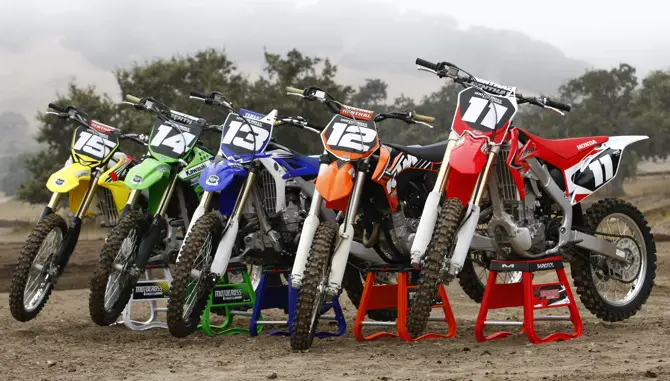
Let’s face it, not everyone is in the market for a 2012 250 four-stroke. That’s okay with us. There are many choices when it comes to purchasing a motorcycle?two-stroke, four-stroke, 125, 250 and 450. Depending on your wants and needs, a 250F might not be your cup of tea. But whatever you decide to spend your hard earned cash on, don’t overlook the positive attributes of a 250 four-stroke. The MXA wrecking crew can attest to the utter delight of holding a motorcycle wide open and blasting around corners.
According to motorcycle sales, as well as our annual reader survey, the vast majority of you reading this shootout are moderately interested in buying a 250 four-stroke. If that’s true, then you’ve come to the right place. Why? The MXA wrecking crew is a concentrated group of racers, spanning all skill levels and ages. We’re a fickle bunch, never satisfied until we’ve exhausted all options. We like to think that we are effective at testing (as well as destroying nearly everything we get our hands on), which is why we have a reputation for telling the truth and finding solutions to a bike’s problems.

For the past several months the MXA gang has put every 250 four-stroke through the wringer. It’s important to note that during the many hours of ride time all bikes were serviced regularly and ran up to their peak performance. More importantly, not a single bike suffered a catastrophic failure (this is something that we couldn’t claim in the early years of 250 four-stroke development).
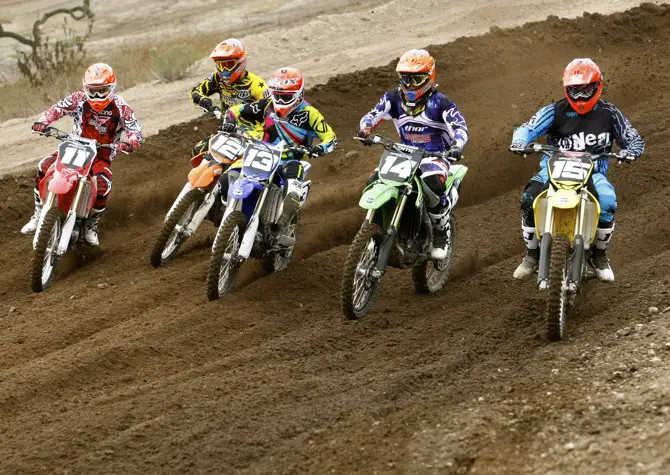
We have not satisfied the desires of two-stroke diehards who want us to put the Yamaha YZ250 and KTM 250SX two-strokes in our 250cc four-stroke shootout. Why not? (1) They aren’t 250cc four-strokes. (2) We did a 250cc two-stroke versus 250cc four-stroke shootout in the October 2011 issue of MXA?and the KTM 250SX two-stroke came out on top because of the horsepower advantage and the lighter weight of the two-stroke. Having said all of this?this is a four-stroke-only comparison.
Behold MXA‘s 250 Four-Stroke Shootout. Find all of the answers to your burning questions. Understand the facts, ponder the positives and negatives, and make a smart purchasing decision.
FIFTH PLACE: KTM 250SXF

Say it ain’t so! Someone had to finish last in this shootout, and the KTM 250SXF was the undisputed loser. Preposterous, you say? After months of testing we’re still shocked and disappointed with the 250SXF. Two years ago KTM seemed to have the competition on the ropes. The Austrians had slowly begun to transform their previously linear powerband into an engine with personality. The bulletproof hydraulic clutch and massive front brake were to die for (and still are). The 250SXF was the lightest bike in the class. Then, without warning, the 2012 KTM 250SXF took a nose dive. KTM’s additions of an electric starter, electronic fuel injection and rising-rate linkage, packed on pudge (the 2012 model weighs a hefty 231 pounds). Worse yet, the Austrian engine coughed out 35.52 horsepower (worst in the class). The KTM 250SXF used to be a race horse, but now it’s an old gray mare with emphysema.

Engine: Test riders described the KTM 250SXF powerband as bland and boring. No matter how you spin it, those aren’t positive adjectives for a 250 four-stroke. Sadly, KTM neutered the engine only two years after making headway toward the front of the class. Our assessment of the 250SXF powerband was confirmed when we ran the Katoom on the dyno?it had four horsepower less than the class leader.
Suspension: Since day one we’ve had problems coming to terms with the suspension on the 250SXF. The spring rates seem to come out of left field, and the forks habitually suffer from midstroke harshness. Guess what? It’s more of the same on the 2012 model. We jumped up a spring rate in the shock (5.1 kg/mm to 5.4 kg/mm) and drained oil out of the forks. Only then did the WP suspension begin to work to our liking.
Handling: Once the suspension is dialed-in the KTM 250SXF rides on rails. The handling, along with the brakes and clutch, are the bright spots in an otherwise ho-hum package. MXA testers love how the chromoly steel frame responds to rider input and admire the precise handling traits. Although not the quickest handling bike in the class, it’s very effective at hitting any line on the track.
The word: We hate to single out the KTM 250SXF, but it’s the only bike in the shootout that regressed since last year. The weight, soft powerband and mismatched suspension are to blame. Expect the Austrians to come out swinging in 2013.
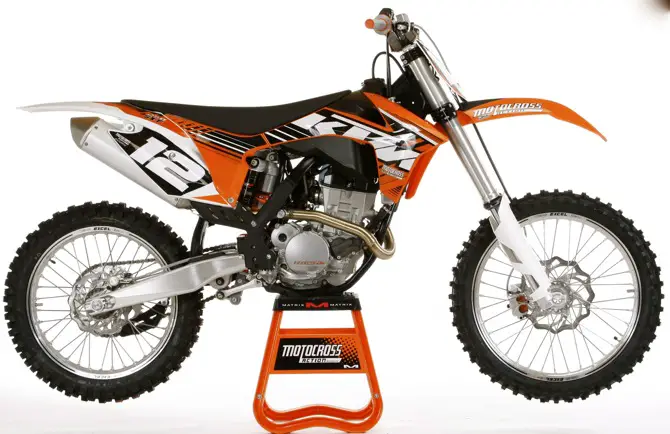
KTM 250SXF RATINGS
Horsepower: 35.52 (at 10,800 rpm)
Weight: 231 pounds
Price: $7699
Powerband: Fifth
Suspension: Fifth
Handling: Third
Brakes: First
Clutch: First
Durability: Second
FOURTH PLACE: HONDA CRF250

We’d love to gush about how much we enjoy the 2012 Honda CRF250, but just like George Washington, we cannot tell a lie. That might seem harsh, but we aren’t telling secrets?Honda is well aware of their numerous issues with the CRF250. Enemy number one is the frame geometry. In 2010 they took a leap of faith with a completely new chassis design (based on the 2009 CRF450 layout), but instead they crashed and burned. Since then Honda’s R&D department has focused on fixing the handling woes while also massaging the engine. As a result the 2012 CRF250 has improved slightly since its introduction (last year the bike finished fifth place). It should be mentioned that Pro level riders preferred the CRF250 to the Yamaha YZ250F (but they don’t use stock engines or suspension). However, a wider range of average racers chose blue over red. Since this shootout doesn’t cater specifically to experts, the CRF250 finished just off MXA‘s 250 four-stroke podium?if you consider third out of five to be podium worthy.

Engine: The CRF250 is potent in the midrange. Thanks to a smaller throttle body (46mm as opposed to 50mm), fuel flows more efficiently into the engine. The result is better low-to-midrange surge. We tip our caps to Honda for meeting the two-meter-max sound test, but sadly the exhaust chokes up the powerband. Finding maximum output from the CRF250 engine requires an aftermarket exhaust system.
Suspension: Right off the bat MXA testers were displeased with the Showa forks. Although the forks remained high in their stroke (something that the CRF250 had problems with in the past two years), they still had a tendency to dive under braking. We blame the funky frame geometry for the faulty fork performance. Even so, the spring rates are too soft for riders over 165 pounds. As unhappy as we were about the forks, the new shock bell crank and longer linkage kept the rear end up in the stroke?and working smoothly.
Handling: It takes a considerable amount of time and trust to become comfortable on the CRF250. Several testers didn’t mind the oversteer and headshake issues once they put a few hours on the bike. Pro level riders came to terms with the chassis because they had enough talent to tame the beast. Even then the CRF250 could corkscrew without a moments notice. In a field of bikes that aren’t are all awesome in the handling department, the CRF250 is the weirdest handling bike in the shootout, bar none.
The word: First and foremost, the 2012 Honda CRF250 can stand to benefit from a new frame with less radical frame geometry. Perhaps then the suspension woul work in every situation and feel more balanced. Then and only then should Honda’s engineers focus on improving the breadth of the engine.

HONDA CRF250 RATINGS
Horsepower: 38.44 (at 11,000 rpm)
Weight: 222 pounds
Price: $7420
Powerband: Third
Suspension: Fourth
Handling: Fifth
Brakes: Fifth
Clutch: Third
Durability: Third
THIRD PLACE: YAMAHA YZ250F

Give credit where credit is due. The first 250 four-stroke on the market (back in 2001) was the Yamaha YZ250F. It is the veteran of the class. Unfortunately the bike is showing its gray hair in one distinct area. That area? The YZ250F could benefit from a new engine. For years Yamaha has tiptoed around the topic?and resorted to Band-Aid fixes. The Band-Aids for 2012 are a larger carburetor bore (yes, the YZ250F is the only 250 four-stroke still carbureted), lighter piston and tweaked crankshaft balancer and counterbalancer. They are, at best, only regenerative cream on the YZ250F’s sore muscles, but they do make the old warhorse better than it was in 2011. The YZ250F, however, shouldn’t be defined by its engine only, because it boasts the best suspension in the class. Best by leaps and bounds. The handling has also been improved. For those reasons the YZ250F bested the Honda CRF250 for third place in our shootout.

Engine: The 2012 Yamaha YZ250F engine is the best YZ250F powerplant ever. Here comes the kicker…it still has a predominantly low-to-midrange powerband. Top-end performance has been bolstered by the big carb, but it can’t compare to the Kawasaki KX250F or Suzuki RM-Z250. Shift often and stay on the pipe in order to get the maximum performance out of the powerband.
Suspension: The Kayaba SSS components are the Tempur-Pedic of the suspension world. Supple and forgiving, every MXA test riders noted that the suspension was the best part of the YZ250F package. Last year Yamaha led us astray by using overly soft spring rates, but they wised up for 2012. We’re thankful, because the Kayaba SSS suspension is buttery smooth.
Handling: Yamaha isn’t scared to change the chassis on the YZ250F. They did so in 2010, and have done it again for 2012. The frame has a new tank-rail cross-section type, swingarm pivot section and engine brackets. It is the most stable and forgiving chassis in the shootout (helped by the fact that its suspension is flawless).
The word: The 2012 Yamaha YZ250F has several positive attributes: (1) The Kayaba SSS suspension is to die for. (2) Handling has been improved over previous models. (3) It is the most durable bike in the class. Having said that, it has one major weakness?a sheepish engine in a class full of hungry wolves.

YAMAHA YZ250F RATINGS
Horsepower: 37.13 (at 11,500 rpm)
Weight: 218 pounds
Price: $7250
Powerband: Fourth
Suspension: First
Handling: Second
Brakes: Second
Clutch: Second
Durability: First
SECOND PLACE: SUZUKI RM-Z250

The Suzuki RM-Z250 was the only bike to rest on its laurels for 2012. Other manufacturers invested time and money into their equipment, while Suzuki didn’t make any meaningful changes (unless you count a new seat cover, different color fork guards, shorter breather hose or material change on the fuel pump assembly as meaningful). Suzuki hasn’t been exactly striking it rich in offroad motorcycle sales since the glory days of the RM250, but that doesn’t mean that they haven’t built excellent bikes over the last few years?they have, but people don’t want to buy them. A classic example of how good their product is can be found in the RM-Z250. It owned last year’s MXA 250 four-stroke shootout with a rip-roaring machine. After pouring assets into an all-new bike in 2010, Suzuki has stuck with the same basic winning package. And, surprisingly, it’s still good enough to finish in the runner-up position.
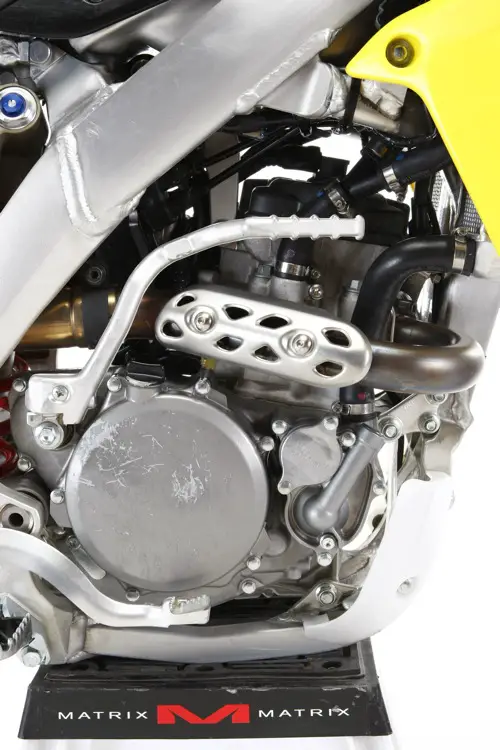
Engine: There’s a reason that the RM-Z250 was relegated to second place in our 2012 shootout, and that reason is all due to the explosive powerband and breadth of the 2012 Kawasaki KX250F. The KX250F’s radical dual-fuel injection technology dethroned Suzuki as having the best EFI system. Despite a lack of internal adjustments to the engine since last year, the heart of the RM-Z250 still beats like a jaguar on performance-enhancing drugs. It’s just muted by the fact that their is a new tiger in town.
Suspension: Tuned for a 140- to 165-pound rider, the Showa suspension does a commendable job of absorbing big hits and small chop. Heavier riders will need to jump up spring rates, but that’s to be expected from a Suzuki. The RM-Z250 isn’t blessed with the best suspension, but the settings are in the ballpark.
Handling: For the Suzuki RM-Z250 the motocross track is an open canvas and the bike is the paintbrush. We’re enamored by the sharp handling characteristics of the yellow zonker. At high speeds the front end has a tendency to suffer from headshake, but that bugaboo can be lessened by dropping the forks in the triple clamps and tightening the steering stem. The RM-Z250 is in a league of its own when it comes to cornering. We love the chassis?plain and simple.
The word: Perhaps you’re surprised that the Suzuki RM-Z250 finished second place despite being the same basic package as a year ago. Don’t be. A imposing racing weapon, the RM-Z250 is an excellent choice for those with an aversion to green.

SUZUKI RM-Z250 RATINGS
Horsepower: 38.12 (at 11,700 rpm)
Weight: 224 pounds
Price: $7399
Powerband: Second
Suspension: Third
Handling: First
Brakes: Fourth
Clutch: Fifth
Durability: Fifth
FIRST PLACE: KAWASAKI KX250F

This victory should not come as a surprise. Over the past seven years the Kawasaki KX250F has won MXA‘s coveted shootout five times. Since 2006 Kawasaki has built a competent 250cc racing war wagon that has always been armed with an explosive engine. Add in the fact that the 2012 KX250F has decent suspension and a chassis that responds better to rider input than in the past, and you have the most complete bike in the class. Truth be told, the KX250F has no equal for 2012. Every single MXA test rider, from Beginner to Pro, selected the KX250F as their bike of choice. Why? Read below.
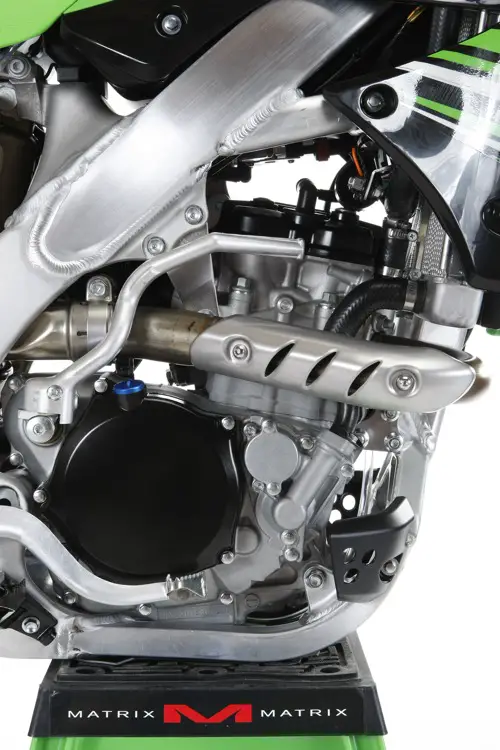
Engine: This bike rips! Several test riders couldn’t believe that the engine was stock. They figured that Mitch Payton had already applied his magic touch to our test bike. The excellent powerband is a direct results of Kawasaki’s dual-fuel injection system. We’ll go so far as to say that dual-fuel the future of EFI. It delivers an added dose of fuel from an upstream injector beginning at 7000 rpm. As a result, high-rpm power and over-rev is increased (two areas that the KX250F engine was lacking in 2011). The new crankshaft also plays a part in creating a dynamite powerplant. This is the best KX250F engine that we have ever tested, and that’s saying a lot. Even bolder?this is the best 250cc four-stroke engine ever.
Suspension: Kawasaki addressed our previous complaints about the soft spring rates and went stiffer on the forks and shock. In turn, most testers were pleased with the performance of the Showa components. We’re particularly fond of the Separate Function Fork (SFF), which is equally inventive and simplistic in design. The suspension might be too stiff for some featherweights, but faster and heavier riders will feel right at home.
Handling: Despite Kawasaki’s attempt at improving the handling traits of the KX250F, the bike still suffers from a vague feeling at turn-in and a rear end that wallows. These problems can be fixed (with different offset triple clamps and a longer pull rod). Even so, the KX250F handles relatively well.
The word: There are four reasons as to why the Kawasaki KX250F won MXA‘s 2012 250cc Four-Stroke Shootout. (1) The powerband is impeccable and trounces every other bike in the class. (2) The suspension is improved and properly sprung. (3) Unlike most of its competition, the KX250F doesn’t have any deal breaking flaws. (4) Did we mention that this engine rips? In the 250 class the engine matters most, and the KX250F is the king of the castle. Need we say more?

KAWASAKI KX250F RATINGS
Horsepower: 39.55 (at 12,800 rpm)
Weight: 224 pounds
Price: $7399
Powerband: First
Suspension: Second
Handling: Fourth
Brakes: Third
Clutch: Fourth
Durability: Fourth






Comments are closed.